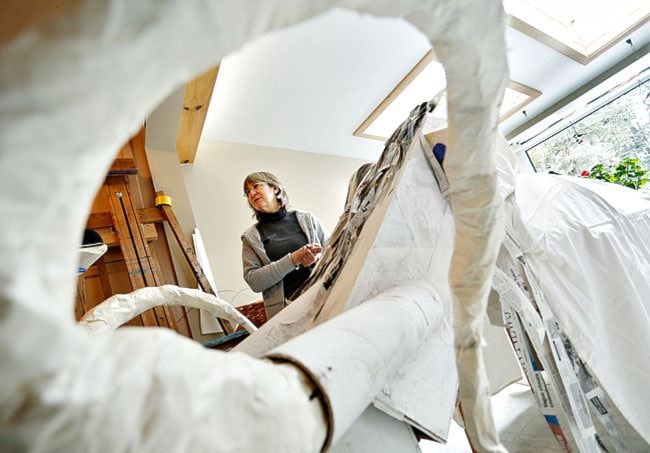If you’re new to the Yukon, you could be forgiven for thinking there’s something a little sinister about an annual tradition in which a procession of people bearing torches gathers round a bonfire after dark to watch an effigy be consumed by the flames.
It might bring to mind other effigy-burnings you’ve heard about, like the annual Guy Fawkes Night celebration in Lewes, England, which has seen the likenesses of Vladimir Putin, George W. Bush and Osama bin Laden crumble to ash in recent years.
But Whitehorse’s annual Burning Away the Winter Blues celebration, which takes place this Saturday at the Robert Service Campground, is something quite different altogether. It’s about joy and rejuvenation, not politics. It’s about letting go of old sorrows and burdens, not about lighting up a 20-foot, shirtless statue of the Russian president holding a rifle (yeah, that happened).
“Burning Away the Winter Blues was born out of the hardship that winter can sometimes have,” said Arlin McFarlane, who started the tradition 18 years ago.
“It was in real honour of the changing of the seasons and the necessity of shucking off the woes of winter when the winter was arduous.”
Every year, the celebration takes place on the Saturday evening closest to spring equinox, when the sun’s on its way back to the North and the winter is just starting to let up.
The ritual starts by the S.S. Klondike, where people gather to light torches and walk along the riverbank to the campground, accompanying the doomed effigy.
At the campground, people have the chance to write down bad memories or burdens they carry and put them into “blues bags.” Then those bags get thrown onto a huge bonfire, along with the effigy.
Traditionally, the effigies have been representations of evil spirits or tortured souls, mostly made out of papier mache.
“It was always about the blues,” McFarlane said. “It was always the unhappiness of the angst of winter.”
But this year’s effigy will be decidedly less mean. It’s a woolly mammoth made by Linda Leon out of cardboard and cloth, complete with long tusks held together by masking tape. Its shaggy fur is made of strips of old newspapers -“we’re burning all that bad news!” Leon said.
Leon believes the effigies have become less sinister in the last few years, as the winters have gotten warmer.
“It used to be colder here in the winter, and people would get cabin fever,” she said. “Lots of people would get depressed because it was too cold to go outside.”
The year she started the annual celebration, McFarlane said, was a long, cold winter.
She realized that giving people a chance to burn their blues away could be a cathartic experience. But it took a lot of work to bring her idea to fruition, mostly because the City didn’t have any bylaws that covered people marching in processions while carrying torches.
So McFarlane had to convince the City and the fire department that this was a good idea.
“They were just uncertain,” she said. “They were uncertain. They’re about public safety, and we were asking about something they’d never dealt with before.”
And over the years, there have been some glitches. One year, an artist put a device in the effigy’s eyes to make them smoulder. Unfortunately, it ended up lighting the effigy on fire before the group had even left the S.S. Klondike.
Last year, Leon said, some kids painted the effigy with acrylic spraypaint. But they didn’t realize the paint contained propellant, which ended up causing a minor explosion when the effigy was thrown on the fire.
But McFarlane believes the annual tradition can do a lot of good for people, despite the minor mishaps.
One year, she said, she found a piece of paper that someone had thrown into the blues bag that hadn’t made it into the fire. She said it was filled on both sides with writing about the person’s family troubles.
“It made me realize that this could be an important symbolic act for people who might have had an extremely difficult winter.”
She said she knows others who’ve given up smoking after the event, as a sort of New Year’s resolution.
McFarlane knows that Burning Away the Winter Blues seems like a pagan ritual. She believes that’s part of its power.
“Paganism is just a real reverence for the Earth and the forces of nature,” she said. “It’s about acknowledging the forces of nature and celebrating the change of seasons, and using that as inspiration for personal reflection.”
These kinds of traditions, she said, can be therapeutic.
“A long time ago, we used to have a lot of rituals ... and now we go to counselling,” she said. “I think it’s symbolic action. Those events have power, and people get drawn back year after year.”
Burning Away the Winter Blues begins at 8:30 p.m. on Saturday at the S.S. Klondike. Participants can also park at the Robert Service Campground and take a shuttle to the S.S. Klondike.
Contact Maura Forrest at
maura.forrest@yukon-news.com
